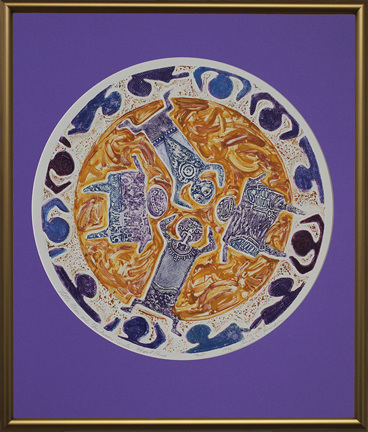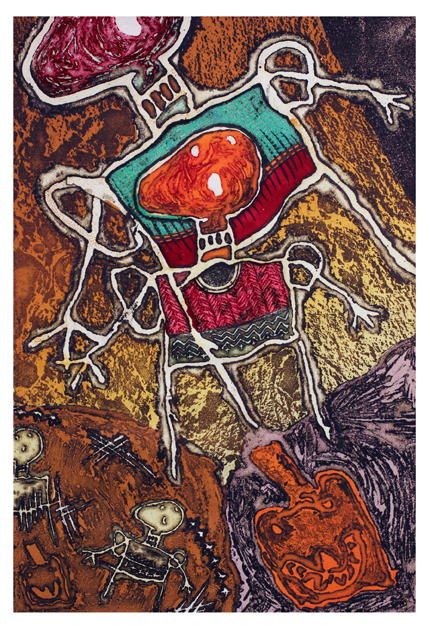 Family Album Hieroglyphics: Jack be Nimble… © 1996, Linda C Everson
October 31 -November 2.
Dia de los Muertos,
Day of the Dead,
All Saints Day,
All Souls Day,
Allhallowtide,
Hallowmas.
And of course, Halloween!
A day to pray for and honor family and friends who died, especially in Mexico, but throughout the world. Traditionally, altars are created, graves visited and cleaned, stories told. Publicly there are parades, art shows, and festivals with altars, costumes, food, and music. Skeleton and skull images are abundant. Candles, flowers (marigolds), and food too. It is not always sorrowful, but can be filled with joy too. It is a celebration of the circle of life!
Family Album Hieroglyphics are a series of intaglio prints by Linda C Everson. The inspiration for the art was her children’s stick figures, which she embelished with backgrounds of rock art, ancient Native American dwellings, and other natural imagery. This intaglio print called Jack be Nimble… references the nursery rhyme Jack be Nimble, Jack be Quick, Jack jumped over the candlestick (or pumpkin). It embodies both a spooky and a playful nature. Halloween of course can be both. And Dia de los Muertos, is meant to be joyful, but traditionally, many believed that if you did not clean the gravesites, the departed would come back to haunt you.
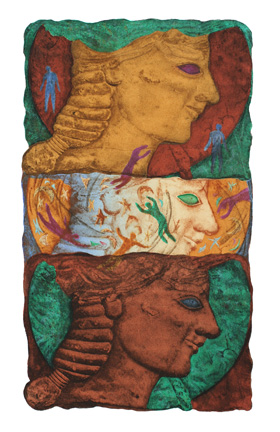 Night Dreams
© 1998. Linda C Everson
28″h x 20″w framed A CLUSTER is a group of similar things or people positioned or occurring closely together. My solarplate print Night Dreams, is currently in an invitational show, CLUSTER, at IceCube Gallery in Denver.
My dreams tend to have clusters of images, ideas, fears, or emotions that keep repeating themselves over and over. And I may have these dreams multiple times… sometimes months or years later. These are called “repetition dreams”. I quite often dream of flying, floating, or falling and I can’t ever stop that process.
In my print, Night Dreams, I included many small figures; some floating, some standing. The figures cluster, swirl, and lurk on top of and around the goddess faces. The multiple faces create a multi-tiered level of mystery. Sigmund Freud said that “dreams are the window to the sub-conscious”.
Bertil Vallien, who’s famous for his sandcasted glass sculptures, often included small floating figures in his vast boat and torso sculptures. His beautiful artwork influenced my own use of floating figures and also the use of vibrant color, transparency, and multiple layers of imagery.
A SOLARPLATE is a steel backed POLYMER PLATE that is light sensitive. Transparencies can be exposed unto the plates by sunlight or UV light boxes. In the Goddess series, I used Kodalith transparencies of photos of goddess faces which I spliced together after printing them in the darkroom. I drew the floating figures onto these transparencies with a opaque pen. After exposure, the solarplate was etched in water which dissolved the unexposed areas, creating textures in the plate.
To create the multiple “flat” background colors (greens, ochres, rust, tan) I made acetate cutouts (like a puzzle) which were rolled with the etching ink and then printed on paper on an etching press. Dark brown and ochre inks were then wiped onto the textured solarplate, and that was printed on top of the flat colors. This required tedious registration and many runs through the etching press to create all the layers of color.
Several years ago, I did a whole series of solarplate prints called the Goddess Series and another called the Torso Series, all based on Greek and Roman sculptures and reliefs which I photographed. In many of those prints, I included small floating figures that swirled through the larger figurative images and/or backgrounds. Some other Goddess and Torso prints that are not in the Exhibit and also are not on my website are depicted below. Please see my CONTACT PAGE is you’re interested in more information.
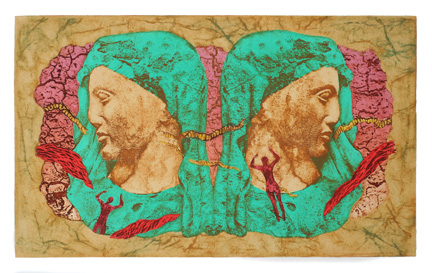 Mirror Image
© 2002. Linda C Everson
18″h x 11″w image size
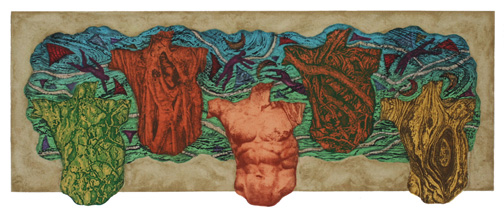 Paper Doll Torsos
©2001. Linda C Everson
10″h x 25″w image size
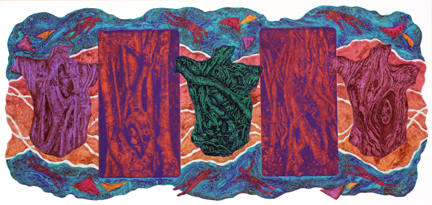 Enchantment of the Trees and Forest
© 1997. Linda C Everson
11″h x 24″w image size
Did you see it on Sept 27, 2015? Blood Moon, a “supermoon”, AND a TOTAL lunar eclipse! This time was more rare than the other Blood Moons mentioned below which were partial eclipses.
I spent the evening observing and photographing this beautiful sight in an open space from just blocks my home. What I observed was the penumbra, or shadow of earth slowly moving across the moon. The moon got dark and then reddish. Because the sunlight acts like a prism and only the red light is bent into the shadow on the moon, we get the reddish hues. The sunrises and sunsets are reflected onto the the moon’s surface.
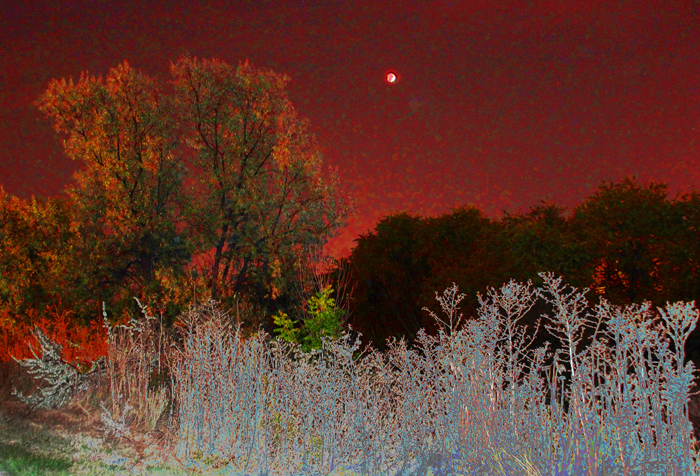
The moon is called a “supermoon” because it’s closes to Earth (perigee) and it appears larger in diameter. “Supermoons” occur 4-6 times a year,
There are 3 types of lunar eclipses: Total, partial and penumbral. The lunar eclipse happens during a FULL MOON. Because the moon’s orbit is slightly inclined to Earth, most full moons are not aligned properly, and so we don’t get an eclipse during our monthly full moons. Lunar eclipses happen about twice a year, but they are not TOTAL, not always at night, which this one was. They say that we’ll not see another TOTAL lunar eclipse until 2033. There have been only five since 1900.
October 8, 2014 was the second of the tetrad of Blood Moons. The first Blood Moon happened April 15, 2014, the third was April 4, 2015, and the final was Sept 27, 2015.
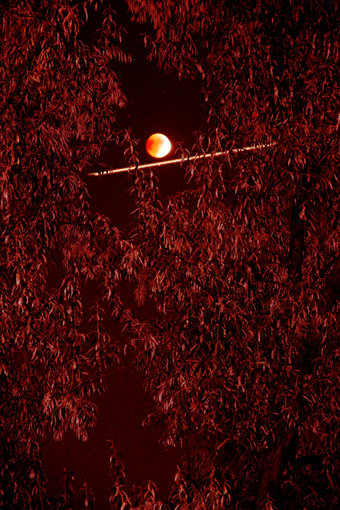
I created several Arborglyph solarplate monoprints inspired by the various supermoons. Image sizes are 6″x 6″. Some people claim “magic” happens during these special occurrences. The imagery in these monoprints has a mysterious, magical quality. Is it a bird, a plane, a helicopter, or a creature floating near the moon?
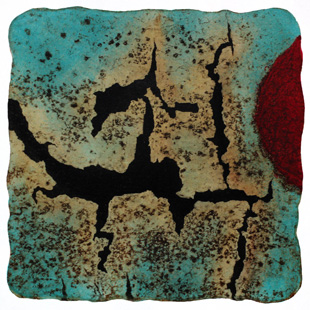 Arborglyph (1 symbol 34) Blood Moon
© 2014. Linda C Everson SOLD 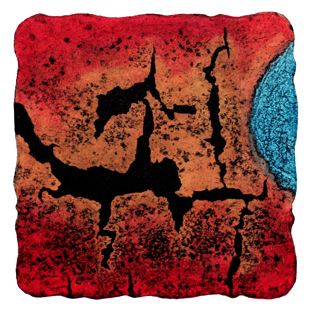 Arborglyph (1 symbol 34) Blue Moon.
© 2014 Linda C Everson A Blue Moon is the second full moon in a solar calendar month. The moon really isn’t blue, but you often hear the phrase “Once in a Blue Moon”, indicating something that rarely happens. Even more rare is a real blue moon when atmospheric conditions such as smoke and dust from fires or volcanoes give the moon a bluish hue.
The MANDALA shape also often represents the universe or cosmos, with the outer circle sometimes representing wisdom. According to The Berzin Archives, there are FOUR levels of offering: an outer offering, inner offering, secret offering, and offering of the nature of reality. Berzin also says that some mandalas are NOT round, but can be bowls, palaces, etc…
 "Little Men and the Inner Circle: The Midas Touch". © 1992. Linda C Everson. Monoprint. 28" x 24". The mandala is significant in many cultures and religions and often a theme in artwork. Currently, three of my mandalas are being shown in the “Spirituality of the Mandala: Reality in the Round” show at Nails in The Wall Gallery St. Lukes in Metuchen, NJ.
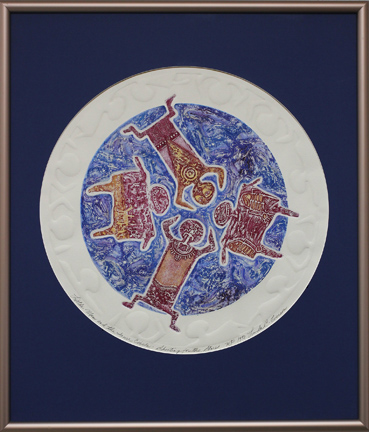 "Little Men and the Inner Circle: Shooting for the Stars", © 1992. Linda C Everson. 28" x 24". Monoprint. My mandala series, “Little Men and the Inner Circle”, is a symbiosis of primitive figures drawn by my children and my photographs of petroglyphs we visited while hiking in the American west. FOUR is a common element in mandalas and my FOUR primitive figures are filled with various petroglyph symbols of man in his environment. There is a sense of self reflection, wonder, timelessness, centering, spiritual energy and the swirling universe in the artwork. The OUTER CIRCLE in my mandalas supports the INNER CIRCLE of humanity.
My art process involved using my children’s FOUR primative images into which I collaged photographic film positives of rocks, petroglyphs, and other textures. These FOUR transparent primative images were exposed onto zinc plates, etched, and then cut into shapes. The figures were used in ALL of my seven mandala monoprints; each printed with different themes, colors and background imagery.
To create the different backgrounds, I used other printmaking techniques such as relief roll, collagraph, painting on plexi, and embossment. All were inked and printed on paper on an etching press.
You can see more primitive monoprints on my website in the Family Album Hieroglyphics series with includes the Little Men and the Inner Circle mandalas.
Stories are not only written but are often told in the form of visual art, dance, theater, etc… My intaglio print “Family Album Hieroglyphics: Man, Full With His Memories” was recently accepted into the catalog for the WCA (Women’s Caucus for the Arts) show “STORIES WE TELL” in New York.
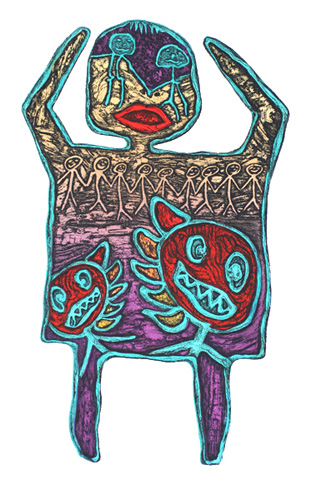 "Family Album Hieroglyphics: Man, Full With His Memories". © 1990. Linda C Everson. All Rights Reserved. Intaglio Print. A symbiosis of two art forms was the basis for the “Family Album Hieroglyphic” series – my children’s “stick figures” and my photographs. When my children were young, our family took many trips in Colorado and Utah. We hiked through the canyon lands and visited many unusual rock formations, cliff dwellings, pueblos, petroglyphs and pictographs.
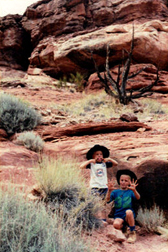 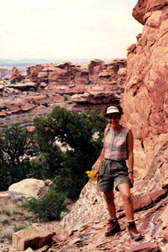
At the time, there was a direct relationship between the primitive “stick figures” my children had drawn and the petroglyphs and western landscapes I was photographing. I combined the two art forms and exposed them on to zinc plates which I etched, inked, and printed on paper on an etching press. That was the creation of this intaglio print series “Family Album Hieroglyphics”.
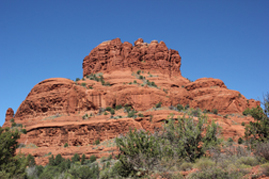 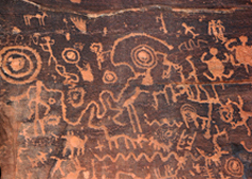
The intense emotions evoked in my children’s “stick figures” validated many family and cultural issues that are commonplace to everyone. Fears, friendship, loneliness, ethnic and gender issues, strife, pets, holidays, sports, and celestial configurations were captured in their simple, yet complex renderings. By combining my children’s primitive “stick figures” and my photographic backgrounds, I created art images that tell multiple stories with a sense of depth and compassion. The “Family Album Hieroglyphic” intaglio prints ALL tell stories and recollect emotions that we can relate to.
“Man, Full With His Memories” brings back recollections of both friends and foe, happiness and hostility. A faceless tree-like figure is imprisoned by hand holding pairs of smiling figures in “Mr. Lonetree Stands Alone”. This print depicts alienation, loneliness, and the need for relationships. “Women, They’re All the Same…” is a common, but inaccurate statement. Although a satirical art piece, my child’s rendition of women’s hairdo’s is humorous. Are women really so robotic in nature? “Jack Be Nimble…” is spoof on the well known rhyme and Halloween spooks. “Indian Memories” is as haunting as Edward Munch’s “The Scream”, which is one of my favorite works of art and depicts intense human emotion. “Man’s Best Friend, Or Is It?” tells about our preoccupation with our favorite pet, the dog.
I’m fascinated with many other primitive art forms and enchanted by the symbolism and story telling involved. I’ve visited many “prehistoric” or Upper Paleolithic caves such as Lascaux in France and Cueva de la Pileta in Spain. The stories about the discovery of these caves is remarkable too! In Lascaux, the sophistication of the so called “prehistoric artists” is exemplified by the overlapping of animals, use of perspective, and blending of colors. Egyptian hieroglyphics in later centuries was a formal pictorial writing system that also influenced my art.
Stories We Tell is a common theme in artwork throughout the ages!
 Arborglyph: (1 symbol 31) Antlers, Ode to the Forests © 2013 Linda C Everson, All Rights Reserved In the last few weeks 12+ fires have been raging in Colorado. Homes and forests have burned, humans and wildlife have been hurt, displaced, or killed. The spectacular flames illuminate our landscape. See colorful photos and videos of past wildfires.
My monoprint – Arborglyph: (1 symbol 31) Antlers, Ode to the Forest is an ODE to Colorado fires in nature. We hope that all the wildlife (DEER included) find REFUGE somewhere. The black branching slash through the art represents both ANTLERS and a PATHWAY. According to Shamanic Journey… “The set of antlers grown by the male deer are antennae that connect it to higher energies.” Because deer antlers can grow back, a DEER can be a symbol of life REGENERATION. May those beautiful forests regenerate quickly.
The DEER family includes various elk, moose, caribou, reindeer, mule, wapiti… & more.
DEER are often associated with gentleness, grace, innocence, sensitivity, intuition, vigilance and regeneration. In CHINA, a deer is the symbol of longevity and wealth.
May the deer (and all other living beings) in the Colorado fires have longevity … and survive the fires.
Mormon Bishop with Samurai Sword Runs Off Attacker. Not too many people wielding those Samurai Swords today…. but they’re still fascinating! Apparently it’s the first time this bishop needed to use the sword in 30 years (other than his martial arts class).
Because very little land was good for farming in Japan, wars over land ownership influenced the rise of the Samurai. In the feudal system, Samurai or “those who serve” were subject to a lord or daimyo, and were very devoted in their support.
Bushido or “The Way of the Warrior” was an important unwritten code of conduct for the Samurai. Seven Virtues of the Bushido Code were: Rectitude, Courage, Benevolence, Respect , Honesty, Honor, and Loyalty. Freedom from fear, duty, discipline, morality, self sacrifice, and sometimes vengeance were also common traits of the Samurai. Many of these codes are still practiced today in modern martial arts.
The Samurai used lots of different swords. The Katana sword was a curved blade sword. In my Arborglyph monoprint below, I used an aspen tree bark marking that vaguely resembles a Samurai figure with the Katana sword. You also see seven circular shapes that could represent the Seven Virtues of the Bushido Code. Text in the background reiterates the various attributes of the Samurai and their codes.
The Seven Samurai, a classic 1954 Japanese movie by Akira Kurosawa, was a favorite of mine in college and it influenced not only my artwork, but endless other famous movies and Spaghetti Westerns. Again… the number Seven!
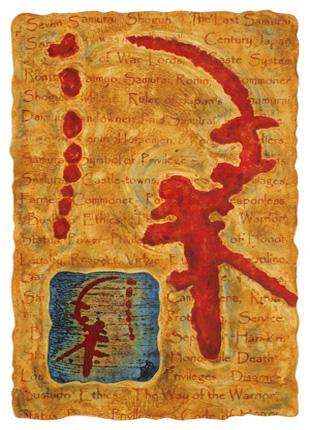 Arborglyph: (1 symbol SAM) Samurai II © 2006 Linda C Everson
Searching for the Stars! Man of La Mancha is a musical by Dale Wasserman based on Miguel de Cervantes modern novel Don Quixote. It’s a play within a play! During the Spanish Inquisition, Cervantes is in prison and puts on a performance about Don Quixote, a madman who is searching for his “impossible dreams”. I saw Richard Kiley perform in this musical on Broadway in the 1970s and William Michals recently at the Arvada Center in CO. What beautiful voices! What a wonderful empowering story!
“To dream the impossible dream… to go where men dare not go. This is my Qwest to follow the STAR, no matter how hopeless, no matter how far… to reach … the UNREACHABLE STAR.”
We all must be Searching for the Stars!
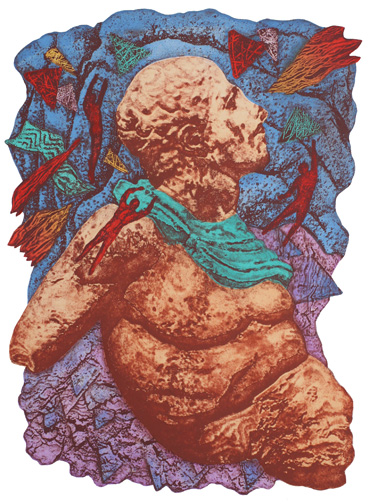 Searching for the Stars © 1996 Linda C Everson
“Everything can be taken from a man but one thing: the last of the human freedoms – to choose one’s attitude in any given set of circumstances, to choose one’s own way.”
Both Cervantes and Frankl experienced imprisonment in their lives and still found hope! Frankl was in a concentration camp and wrote this book about his beliefs of optimism and having a purpose in life , “no matter how hopeless”… Keep Searching for the Stars!
Annual Holocaust memorial day was on April 8. In commenoration, I recently saw the Colorado Ballet dance performance of Light / The Holocaust & Humanity Project . Such a POWERFUL expression of one female Holocaust survivor! The 5 movements showed a progression from the birth of man – Adam & Eve and the Tree of Life, to a wedding celebration, and then quickly transformed into the harrowing scenes of bigotry, isolation, degradation; with dancers depicting crowded train cars and death camps, beatings, gas showers, death, and ultimately… rebirth and survival as the final movement. The ‘circle of life’ theme carried on throughout this emotional performance. See a short clip of this powerful dance where the choreographer Stephen Mills’ premiered Light / The Holocaust & Humanity Project at the Austin Ballet in 2005.
Musicians, dancers, and artists express the “essence of the human experience” in many powerful ways. Coping is difficult and inner strength imperative for survival. I find that performances like Light /The Holocaust & Humanity Project transcend other more popular dances, and these types of themes are influential in my own creation of artwork. Reading, theatre, art movies, and dance all invigorate me. Art influences art!
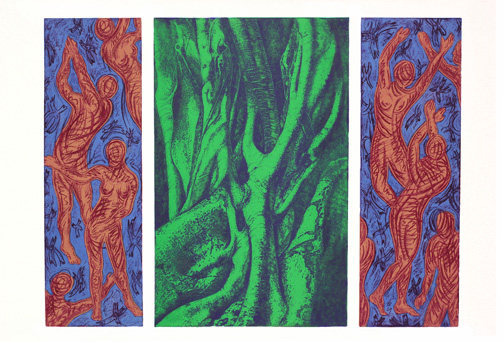 Twisting, Turning, Dancing, Yearning © 1995 Linda C Everson The Tree of Life is common term used in science, philosophy, mythology, and by many cultures and theologies. It is found in the Book of Proverbs depicting “wisdom” and in the Book of Genesis in relation with Adam and Eve being cast from the Garden of Eden. It can represent the “interconnection of all life on our planet”. The Tree of Life is a powerful metaphor in all art forms. Despite atrocities, life moves on…
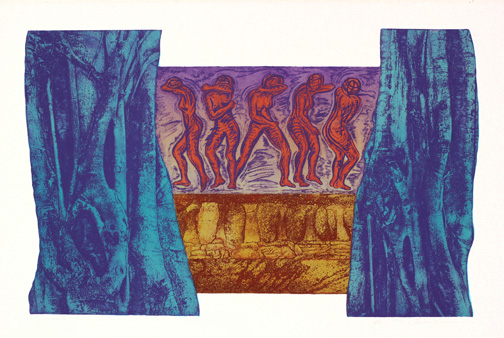 Movement © 1995 Linda C Everson
I recently saw the Life of Pi movie by Ang Lee twice. I had read the book by Yan Martel several times, and since I loved all the spiritualism and symbolism in the story, I created a colorful Arborglyph monoprint on that theme in 2005.
 Arborglyph: (1 symbol P) The Life of Pi, © 2005 Linda C Everson Just a FEW WORDS in my artwork that convey all the THOUGHTS, FEELINGS, AND VISUAL IMAGES that I got from that incredible Life of Pi story are: sink, ship, swells, shelter, sunshine, sharks, selfish, sacred, sacrifice, security, religion, reality, reason, routine, passage, predator, protect, fear, fish, fight, hope, horizon, zebra, zoo, alpha, omega, animal, instinct, illusions, illumination, meerkats, map, world, wet, waves, wind, weary, wish, will, deprivation, danger, delirium, determination, dignity, dolphins, death, darkness, think, threaten, territory, trials, tiger, teamwork, taming, and … TAMING THE TIGER!
The multiple levels of humor and seriousness, life and death, animal instinct and spirituality, god and man, fear and wonder, reality and illusion, self-determination and guidance; are all explored in the book and the movie. You can read or watch Life of Pi many times, questioning, wondering, and gaining more insight.
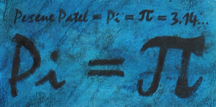 For a humorous example, the hero, Picene Patel was named after a swimming pool (picene) and in grade school was constantly ridiculed over his name… ‘Pissing Patel’. Cleverly, he changed his name to Pi, a mathematical symbol, which shows you how bright he really was in a challenging situation. His curiosity often got him into major trouble, but also enlightened him with the best attributes of three religions. His beliefs in both multiple gods/one god provided strength for him while stranded at sea for an eternity. Like the Pi symbol whose decimal representation never ends, his lifeboat experience goes on and on… For a humorous example, the hero, Picene Patel was named after a swimming pool (picene) and in grade school was constantly ridiculed over his name… ‘Pissing Patel’. Cleverly, he changed his name to Pi, a mathematical symbol, which shows you how bright he really was in a challenging situation. His curiosity often got him into major trouble, but also enlightened him with the best attributes of three religions. His beliefs in both multiple gods/one god provided strength for him while stranded at sea for an eternity. Like the Pi symbol whose decimal representation never ends, his lifeboat experience goes on and on…
My use of the Arborglyph – P symbols in my monoprint is reminiscent of both Pi’s name and also the CHI RHO CROSS. I wanted to convey both a sense of mystery and a spiritual element. Interestingly, the Chi Rho Cross was supposedly used by Constantine in a major battle over territory and helped him accomplish a difficult win over his enemy. Another account “credits his victory to divine intervention”. In the Life of Pi, Pi (Picene) is also faced with major hurdles to survive in a small territory that both he and his enemy (Richard Parker the tiger) want to claim. Was it self will power or divine intervention that helped Pi survive? While Constantine saw his Chi Rho symbol in the sky, Pi also saw wonders of the almighty maker through the beauty of the sea and the sky, which was superbly portrayed in the Ang Lee movie. The turquoise waters and the rust colored tiger stripes were gorgeous! It’s a beautiful story told in many ways… a book, a movie, a piece of artwork.
|
|









